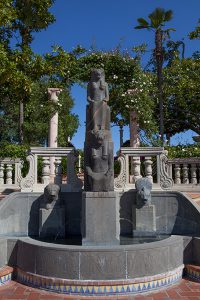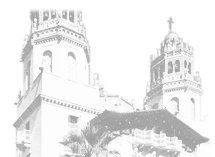
The name Sekhmet literally means “the powerful one.” Shown with the body of a woman and the head of a lioness, she was the bloodthirsty daughter of Ra, the Egyptian sun-god. The disc on her head symbolizes the sun. As goddess of war, she was a destroyer, but she was often invoked as the protector of the pharaoh and thus as a healer. Hundreds of images of Sekhmet are known. Many were commissioned by Amenhotep III (reigned 1411-1375 BCE) for the temple of the goddess Mut in southern Karnak. He also installed sculptures of Sekhmet at Thebes. The four sculptures at Hearst Castle, carved from diorite (dark granite), date from the New Kingdom of Egypt (c. 1550-1070 BCE) and are the oldest works of art at Hearst Castle. Hearst bought them from different sources; at least one was in his collection in New York before being sent to San Simeon. On his recommendation, Julia Morgan combined them to create this impressive grouping on the esplanade of the Enchanted Hill.
Egyptian. Head on the left, 18th Dynasty (c. 1550-c.1295 BCE); three others, 19th Dynasty (1292-1189 BCE).


